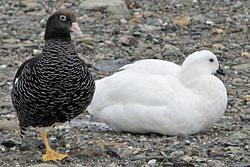| Kelp goose | |
|---|---|
 | |
| Scientific classification | |
| Kingdom: | Animalia |
| Phylum: | Chordata |
| Class: | Aves |
| Order: | Anseriformes |
| Family: | Anatidae |
| Genus: | Chloephaga |
| Species: | C. hybrida |
| Binomial name | |
| Chloephaga hybrida (Molina, 1782) | |
| Subspecies | |
| |
 | |
The kelp goose (Chloephaga hybrida) is a species of waterfowl in tribe Tadornini of subfamily Anserinae. It is found in Argentina, Chile, and the Falkland Islands. [2] [3]





